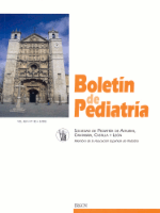Revisión de los métodos de screening en hipoacusias
J. Urdiales Urdiales , E. Álvaro Iglesias , I. López Sánchez , G. Vázquez Casares , J. Piquero Fernández , M Conde López , F. Fernández Calvo , P. González López , J.M. García Vela
Bol. Pediatr. 2003; 43 (185): 272 - 280
Introducción: La detección precoz de la hipoacusia tiene importancia para instaurar rehabilitación auditiva temprana y conseguir el desarrollo normal del lenguaje. Por este motivo se han desarrollado programas de screening auditivo en neonatos, que se iniciaron en pacientes con factores de riesgo de hipoacusia. El estudio neurofisiológico de potenciales evocados auditivos del troncocerebral (PEATC) constituye un método objetivo de detección precoz de trastornos de la audición y evaluación funcional de la vía auditiva. Objetivos: Estudiar la incidencia de hipoacusia en neonatos y niños con factores de riesgo en nuestra área asistencial así como hacer una revisión de los métodos de screening de hipoacusia con análisis coste-efectividad. Métodos: Se realizó PEATC, años 2001 y 2002, a todos los neonatos y niños que presentaron algún factor de riesgo audiológico o neurológico, basándose en los criterios de la Comisión Española para la Detección Precoz de Hipoacusia. El estudio incluyó 157 niños con edades desde el nacimiento hasta los 5 años. Conclusiones: El resultado muestra en niños con factores de riesgo una incidencia de 7,6% de hipoacusia neurosensorial y 2,5% de hipoacusia neurosensorial profunda bilateral. El realizar este programa de screening permitió disminuir la edad de detección de la hipoacusia en los neonatos antes de los 6 meses de edad. Abstract Introduction: The early identification of hearing loss is very important to begin a early rehabilitation and to get a normal development of the language. Because of this reason, programs of hearing screening have been developed for newborns, mainly in cases with risk factors. Neurophysiological study Brainstem auditory evoked Response(BAER) is an objective test that provides an early detection of hearing loss and a functional evaluation of the auditory pathway. Objectives: To study the incidence of hearing loss in children with risk factors in our field of primary care and to make a revision of hypoacusis screening with cost-effectiveness analysis of universal newborn hearing screening methods. Methods: All newborn and children presenting some factors of audiologic or neurologic failure, based on the criteria of the Spanish Commission for the Early Detection of Hypoacusis, were tested by BAER, in the years 2001 and 2002. The study included 157 children, between the ages of birth and 5 years old. Conclusions: In cases of children with risk factors, the results show that the incidence of sensorineural hearing loss is 7.6% and of bilateral profound hearing loss is 2.5% The age of identification of hearing loss was decreased in newborn under 6 months with the hearing screening programs. Conventional BAER has long been recognized as the most sensitive method of assessing the auditory acuity of newborns. However, it was thought to be too expensive and time-consuming a procedure for initial stage screening. To use automated universal screening equipment can reduce costs and increase cost-effectiveness.
\N
\N
Artículo completo (PDF) (102 kb.)
- Neonatología
